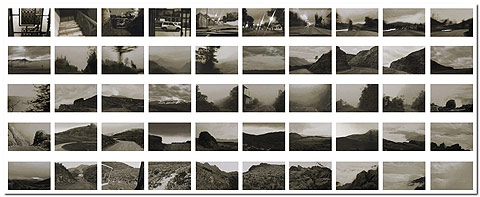DPM Gallery,
Nov 11, 2006 - Dec 11, 2006
Guayaquil-Miami, Ecuador
Travelling Instructions*
by Cristóbal Zapata
The apotheosis of his walkabouts is culminated in Lejos cerca lejos ("Far close far", 2004), the most ambitious of Cardoso’s series. It is the chronicle of his journey to Sao Paulo, from the moment in which he leaves is house in Cuenca until he arrives at the site of the biennial in Sao Paulo. Like a logbook where stopovers, form-fillings and other incidents of navigation are consigned, the 320 tablets that constitute this series - as in his previous trajectories or wanderings "more than a history of a journey are the 'telling' of it." While a history is the narration of the facts as they occurred, the telling of it implies a manner of referring, a strategy of representation: the formulation of will that orients artistic creation. Although Cardoso transfers literally his photographs to the wooden tablets, and these are organized in strict chronological sequence, the chromatic selection (a scale of grays and sepias), the intercession of the lens with its unexpected errors (blurred or overexposed images), or his intentional special effects (alterations in focus), his pauses (those white tablets that revere silence), and their ultimate transferal to the language of painting contribute to filtering out the real data, transforming the story into a tale, that is, into poetic fiction.
But there is more to it: the 55 roundels which make up Geodesia, the 70 wooden tables of 29.IV.02, the 159 of 18.VI.02, and the 320 "stations" of Lejos cerca lejos, not only speak of a laborious and loving disposition toward the craft of painting - unusual in the times we live in - but they seem to bring up to date the notion of delay, fundamental to the pictorial conception of Duchamp. Thus, from the standpoint of the concentration and repose which his vast and meticulous projects require, Cardoso paints confronting the frivolous wildness of the world, but above all, to retard the omnivorous and frightening passage of time.
Commenting the fantastic style of the English poet Robert Browning, Chesterton says " . . . he enjoyed working in that style like a Chinese potter could enjoy making dragons, or a medieval sculptor modeling devils",(2) the miniaturist and meticulous art of Cardoso shares this kind of patient and joyful workmanship, this sacred devotion to painting.
2. Folds
In his disquisitions on the Baroque, Eugenio D’Ors compares the 17th Century, the great baroque century, with Alexandria: "In both epochs - he says - Culture is bathed in landscape".(3) With the setting aside of nature which marks the end of the modern period, and the successive transformation of culture into "second nature", which signals the beginning of postmodernity, we cannot but invert the formula of the Catalonian aesthete: today, landscape is bathed in culture "now in lower case, since contemporary art has breached the gulf between high and low culture". Perhaps it is here that resides one of the secrets and profound meanings of the recent works of Cardoso: in the seascapes which make up the series Coordenadas ("Coordinates", cycle of paintings which the artist has worked on since 2003), as in his new series Sábanas ("Bed sheets", 2005-06), restate from the standpoint of painting our vision and relationship with landscape, and postulate the possibility of their existence through a cultural filter.
To begin with, Cardoso gives landscape a cultural bent by delivering his painting through photography, transporting the initial photographic registry to the dominion of acrylics, and additionally, in the case of his landscapes, unfocusing the object in a way that it becomes an opaque, veiled, foggy landscape - similar to the blurred paintings of Gerhard Richter or Gottfried Helnwein, obvious and admitted models of his work - as if they were in the process of configuration or disintegration, accenting their "irreality", their lack of reality. The cultural mediation lies precisely in the use of the camera, in the manipulation of the technical apparatus, since the intervention of the lens introduces an analytic and critical distance faced with the object: nature lost, extinguished, can only return as a shadow or ghost, even though that "shadow" be mathematically located on the map in virtue of its coordinates: (i.e. 00° 43.67’ S - 89° 26.10’ W, the title of a painting in this series).
|









